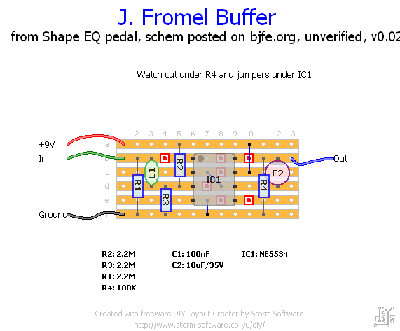Yes that's nifty solution using an integrated charge pump. Those are getting a bit less expensive these days I gather.
Very cool Soulsonic!
For large signal inputs such as even speaker outputs the inverting mode is excellent.
For low level signals noise gain is of consideration and it's one serious consideration in mixer amplifiers.
Noisegain is the amplification of the internal noisegenerators in the chip and is defined by the feedback network +1and can therefore at lowest be 1 time as in a noninverting buffer or an inverting amplifier with zero Ohm's feedback.
Here given three examples of noisegain:
A noninvertingbuffer:
Noisegain is then 1
An inverting buffer:
Noisegain is then 2 since then basic gain expression gives
R1/R2 when R1=R2 gives 1 and that added to 1 gives 2
A unitygain mixer:
Noisegain is R1/R2+1 but R2 is now defined by all input resistors parallelled while under unity gain for signals then gain per channel is R1/R2 per channel.
However noisegenerators inside will be amplified by under these conditions by R1/ ( R2x N) where N is the number of channels.
It follows that with ten inputs each at unity gain the noisegain will be 20dB.
With series amplifiers the noisegain adds on in dB's and so two in a row unity gain inverting amplifiers have a noise gain of 12dB.
Noisegain is the factor with which noise is amplified and not to be confused with the factor with which signals are amplified.
Further optimizing noise preformance of an NE5534A, which has lower noise factor than its dual sibling NE5532, it can be shown that lowest noise from result in noninverting mode when source impedance is between 5 and 10K approximately 6K8 ..
A guitarpick up has a DC resistans in the vincinity but the total impedance can be more than ten times at resonance- actually a guitarpick up is a troublesome source
There are always trade offs:
With a dual inverting design inputs are protected at all times and it can handle large signalswings and it can be simple. And the Soulsonic design is a more orless bulletproof design that can take a lot of abuse. However noise could be lower.
Note that on higher supplies total distance to noise can be increased as larger signals can be handled also very few OP amps are designed to work at low voltages.
The NE5532 and NE5534A can both work down to 6V's or from a bipolar supply at 3V's each rail
In a noninverting design then noisepreformance can be optimized but at the same time a number of things need to be protected. Noise gain can then be 1 as opposed to 12dB's and generally noise preformance is better via the noninverting input. With proper protection a noninverting unitygain buffer can be made more or less bulletproof too.
Simple transistor buffers such as the common collector circuit as used in most guitarpedals gain is invariably lower than 1. See 'When is a Buffer needed?' thread on mnore on this.
Here's an interesting thing:
There's an early edition of japanese overdrives that have two dual OP amps and outof those four OP amps two are used as buffers. However the chips choosen have a bit high noisefigure and so simplifying this by changing the buffers to CK types then noise goes down but so does voltage amplification.........however since switching is electronic and the buffers active at all times then it makes little difference............or?
One can make a transitor buffer with with emitter output that has a gain of exactly 1 but it makes the emitterload a bit complicated and personally I have only seen that used once in a HiFi
Now it follows one can in a buffer pursue gain of one ( maybe a little more as is done in one once made in Japan Chorus that is quite famous); or one can try to get lowest noise and at any rate try the best to protect the circuit from failure; and or one can pursue getting the highest headroom or one can pursue making the lowest cost or most effective per cost.........
While there are many ways of optimizing even something like a buffer thinking about what would be good to optimize gives a greater understanding of the use oif buffers.
Oh and a very cool buffer with two outputs one in phase and one outof phase could result from this discussion.
Consider that being able to alter phase can be most useful in some effects systems:
There was a bassplayer at my shop a few weeks ago with a phase related problem and it could be solved by inserting an inverting buffer after one of his pedals.
Phaseangle becomes important when compared to another phaseangle.......
In bass systems effects can often be placed parallell so as not to loose the deep end
Just some thoughts.
Have fun and carry on gentlemen



